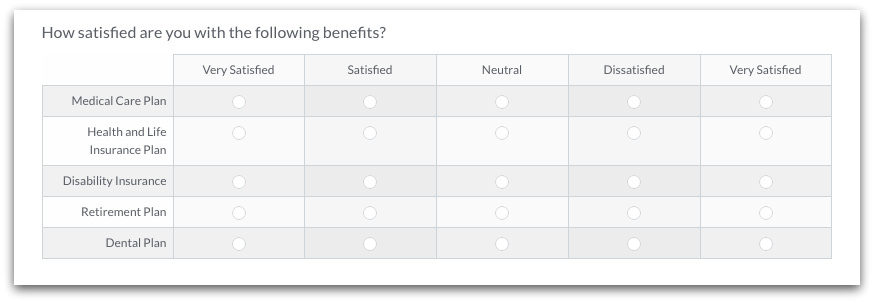Businesses have been issuing customer satisfaction surveys since the beginning of time...or at least a pretty long while. Why? Because providing top-notch customer service and an exceptional customer experience is an increasingly important value for businesses. But what about employee satisfaction? Does your business value employee happiness? Is your human resources department spending enough time nurturing employees and providing a top-notch work experience? If not, it’s time to start. One great way to jumpstart your efforts is through an employee survey. Surveying your employees about the various aspects of their jobs and work environments can help you gather valuable feedback on their overall satisfaction and engagement with the company. You can conduct specific employee surveys, like a job evaluation survey or an employee benefits survey, or you can conduct a comprehensive survey that digs into employees’ feelings on all aspects of their jobs. A comprehensive survey can help you quickly determine where your company might be falling short in meeting employee needs. To uncover potential workplace issues that could cause you to lose great team members, you need to ask the right questions on your employee survey. Here are 7 sample employee survey questions that can help you capture meaningful feedback and plan for increased happiness and productivity at your business.
Question 1: How happy are you with your role and responsibilities at this company?
If you want to know how your employees feel about their positions and job tasks, ask them! All comprehensive employee surveys should include a question that gauges employees’ overall job satisfaction. Asking this question will give you a big-picture view of employee happiness at your company. If only 10% of employees express unhappiness, you’re likely doing a thing or two right. To keep this question simple, use a Radio Button field and a range of choices, such as “Very Happy,” “Happy,” “Somewhat Happy,” “Somewhat Unhappy,” “Unhappy,” and “Very Unhappy.” For further insight, you could apply Conditional Logic that asks employees to explain any negative response.
Question 2: Do you have the tools and resources you need to perform your job well?
If you want to create a positive and successful business, it’s important to ensure employees have what they need to get the job done. Your employee survey should include at least one question that lets you know if your company is meeting employee expectations when it comes to available equipment, resources, training, etc. This can be a simple yes-or-no question, but you’ll get more valuable information if you add Conditional Logic to any “No” response to find out what resources the company is missing.
Question 3: Are you satisfied with the company’s benefits package?
Asking employees how they feel about the benefits your company offers can help your human resources department evaluate and plan benefits options. When you conduct an employee survey, it’s always a good idea to gather feedback on benefits packages since these packages can be used to retain current employees and recruit new employees.If you want to gather feedback about specific benefits, you can use a Matrix field to let employees rate their satisfaction level for each benefit. For example, the question could be “How satisfied are you with the following benefits?” And each benefit could be listed next to a range of satisfaction ratings (i.e., “Very Satisfied,” “Satisfied,” “Neutral,” “Dissatisfied,” and “Very Dissatisfied”).

Question 4: How would you describe your relationship with team members and other colleagues?
Asking about the relationship among team members and colleagues can help you find out if employees feel respected and appreciated among coworkers. It can also give you an idea of the overall employee rapport at your business.You could leave this question open-ended and use a Long Answer field, or you could provide multi-select options via a Checkbox field. For example, you could provide options such as “Friendly,” “Respectful,” “Positive,” “Negative,” “Dysfunctional,” and “Nonexistent.”
Question 5: Do you feel the leadership team clearly communicates company wins, struggles, goals, and strategies?
Comprehensive employee surveys should almost always include a question that reveals how employees feel about upper managers or leaders in the company. If you want to create a great work environment, you need to make sure employees don’t perceive a large communication barrier between the leadership team and everyone else. Here, you can use a Radio Button field and a range of options to let employees express the level of openness they perceive. For example, the options could be “Always,” “Usually,” “Sometimes,” and “Never.”
Question 6: Does the company allow you to maintain a satisfactory work-life balance?
Work-life balance is important to most working adults, so you’d be wise to find out how your company is doing in this area. A question like this can help you determine if employees are satisfied with their work schedule, flexibility, vacation time, and more.Like question #2, this can be a simple yes-or-no question, but you’ll get more insightful feedback if you add Conditional Logic to any “No” response to find out where an employee’s dissatisfaction lies.
Question 7: Would you tell friends and family this is a fun place to work?
Engagement is an important factor when it comes to employee retention, so you should include a question on your employee survey that evaluates how happy your employees are at work. If you’ve established a positive culture and work environment, your employees should think your company is a fun place to work.For this question, you could include a “Maybe” option along with the standard “Yes” or “No.” And you could, once again, use Conditional Logic to probe for further information on any negative response.
Ready to use these sample employee survey questions to create your own employee survey? Click here to see how Formstack can help you take the next step.











